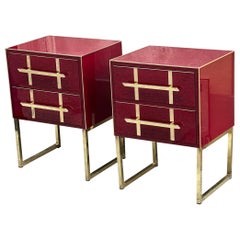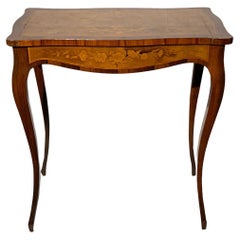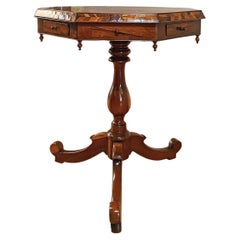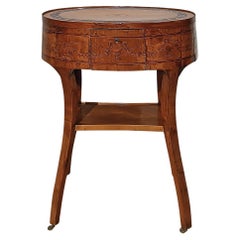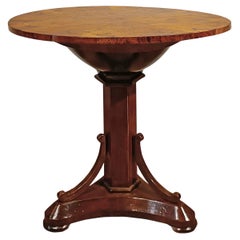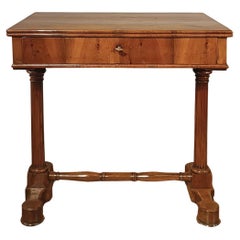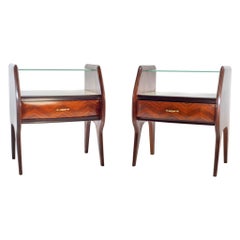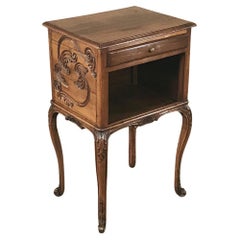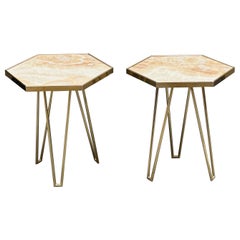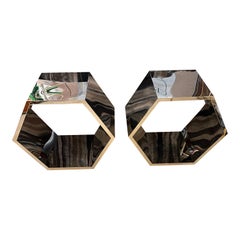Florence - End Tables
to
Height
to
Width
to
Depth
to
6,022
1,381
17
1
1
1
4
12
1
1
1
17
8
7
3
3
18
13
2
1
1
18
17
18
Item Ships From: Florence
Italian Burgundy Opaline Glass Nightstands, Brass Handles and Inlays, 1980
Located in Florence, IT
Italian burgundy opaline glass nightstands with two drawers, brass handles, inlays and legs. Can be also used as end tables.
Category
Late 20th Century Italian Modern Florence - End Tables
Materials
Brass
MID 19th CENTURY NAPOLEON III INLAID TABLE
Located in Firenze, FI
Splendid wooden coffee table entirely decorated with fine inlays of precious woods such as walnut, olive and rose. The inlays concern floral details present on the top and sides, whi...
Category
Mid-19th Century Italian Napoleon III Antique Florence - End Tables
Materials
Olive, Walnut
FIRST 19th CENTURY CHARLES X COFFEE TABLE WITH INLAID TOP
Located in Firenze, FI
Elegant coffee table in solid walnut, embellished with parts finely inlaid with various fruit woods. The octagonal top is decorated with geometric and heart-shaped inlay designs, typ...
Category
Early 19th Century Italian Charles X Antique Florence - End Tables
Materials
Fruitwood, Nutwood
LATE 18th CENTURY DIRECTOIRE COFFEE TABLE WITH INLAYS
Located in Firenze, FI
Elegant small side table made of carved cherry and walnut, enriched with ebonized pastiglia inlays. The inlays, which adorn both the top and the band of the undertop, feature geometr...
Category
Late 18th Century Italian Directoire Antique Florence - End Tables
Materials
Cherry, Walnut
EARLY 19th CENTURY CHARLES X COFFEE TABLE IN WALNUT
Located in Firenze, FI
Elegant coffee table in solid walnut with walnut root veneer, featuring a round top supported by a central hexagonal shaft, which ends with three feet with a single base adorned with...
Category
Early 19th Century Italian Charles X Antique Florence - End Tables
Materials
Walnut
EARLY 19th CENTURY CARLHES X WALNUT TABLE
Located in Firenze, FI
Elegant coffee table in carved blond walnut. Originally designed as a work table, it can be used as a small desk or console. The fluted columns and the molded footrest give a touch o...
Category
Late 18th Century Italian Charles X Antique Florence - End Tables
Materials
Nutwood
EARLY 19th CENTURY GILDED WOOD TEA TABLE
Located in Firenze, FI
This tea table, made of fine carved wood and subsequently gilded with pure gold leaf, is an authentic masterpiece of design and craftsmanship. Characterized by a round fabric top, el...
Category
Early 19th Century Italian Antique Florence - End Tables
Materials
Crystal
LATE 18th CENTURY ROUND DIRECTORY WALNUT COFFEE TABLE
Located in Firenze, FI
Elegant coffee table embellished with solid walnut legs and a poplar top veneered with walnut. The legs feature curved saber shapes, typical of the period, while the smooth top is en...
Category
Late 18th Century Italian Directoire Antique Florence - End Tables
Materials
Walnut
Blossom float brass rectangular coffee table
Located in Firenze, FI
Enhance your living space with our stylish coffee table featuring a removable rectangular tray with rounded corners. Made with a sturdy brass frame and topped with elegant glass, it ...
Category
2010s European Florence - End Tables
Materials
Brass
$2,323 / item
LATE 19th CENTURY LOUIS XVI STYLE COFFEE TABLE
Located in Firenze, FI
Elegant Louis XVI style coffee table, crafted from solid carved walnut and embellished with walnut and olive wood veneers. The structure is distinguished by its four truncated pyrami...
Category
Late 19th Century Italian Louis XVI Antique Florence - End Tables
Materials
Olive, Walnut
FIRST HALF OF THE 19th CENTURY CARVED WALNUT COFFEE TABLE
Located in Firenze, FI
Elegant coffee table in walnut root and carved solid walnut. The oval and curved top is equipped with a practical hidden drawer, ideal for storing small objects. The legs, finely tur...
Category
Early 19th Century English Antique Florence - End Tables
Materials
Walnut
FIRST 19th CENTURY ORIENTAL STYLE EBONY TABLE WITH INLAYS
Located in Firenze, FI
Elegant side table in carved and ebonized wood, characterized by a refined oriental style. The frame and three-legged legs feature elaborate moldings, and the feet are also adorned w...
Category
Early 19th Century French Antique Florence - End Tables
Materials
Stone
EARLY 19th CENTURY BIRCH OPENING TABLE
Located in Firenze, FI
Splendid table in light birch wood, finely carved. The table is characterized by an opening top with a lock on the front, inside which there are practical compartments for storing sm...
Category
Early 19th Century Austrian Antique Florence - End Tables
Materials
Birch
FIRST HALF OF THE 19th CENTURY SMALL WORK TABLE IN WALNUT
Located in Firenze, FI
Elegant small work table in walnut root, enriched with carvings and fillets in fruit woods. It is characterized by turned and carved legs, decorated with vegetal and geometric motifs...
Category
Early 19th Century French Antique Florence - End Tables
Materials
Fruitwood, Nutwood
LATE 18th CENTURY DIRECTOIRE COFFEE TABLE WITH WALNUT VENEER
Located in Firenze, FI
Elegant small side table, made of walnut veneer. The top is embellished with a refined inlay in fruit woods, which gives further elegance to the complement. The semi-curved legs are ...
Category
Late 18th Century Italian Directoire Antique Florence - End Tables
Materials
Fruitwood, Walnut
EARLY 19th CENTURY SMALL WORKING TABLE
Located in Firenze, FI
This splendid and refined cherry working table, of Tuscan manufacture from the early 19th century, is a unique piece that can also be used as a small desk. Its ancient function was t...
Category
Early 19th Century Italian Antique Florence - End Tables
Materials
Wood, Cherry
MID-19th CENTURY EBONIZED WOOD COFFEE TABLE WITH INLAYS
Located in Firenze, FI
Elegant coffee table in carved and ebonized wood, with inlays and bone fillets on the top. The lyre legs, characterized by a refined silhouette, are supported by shaped crosspieces. ...
Category
Mid-19th Century Italian Antique Florence - End Tables
Materials
Harewood
END OF THE 19th CENTURY GOLDEN TABLE IN NEOCLASSIC STYLE
Located in Firenze, FI
Splendid and elegant gilded wooden coffee table, in neoclassical style. The rectangular top with circular sides is enriched by a refined fabric covered by glass, which gives further ...
Category
Late 19th Century Italian Neoclassical Revival Antique Florence - End Tables
Materials
Fabric, Glass, Wood
Related Items
Midcentury Italian Nightstands in the manner of Vittorio Dassi
By Vittorio Dassi
Located in Albano Laziale, Rome/Lazio
A pair of handmade nightstands by Vittorio Dassi. Each nightstand has a pair of doors with an intricate zigzag design, glass shelf and details in ...
Category
1950s Italian Mid-Century Modern Vintage Florence - End Tables
Materials
Brass
$3,456 / set
H 23.63 in W 20.48 in D 13.78 in
19th Century French Louis XV Walnut Nightstand ~ End Table
Located in Dallas, TX
19th century French Louis XV walnut nightstand ~ end table is remarkable in that it's carved on all four sides with wonderful Rococo...
Category
1870s French Louis XV Antique Florence - End Tables
Materials
Walnut
French 19th Century Round Table with Leather Top
Located in New Orleans, LA
This beautiful circular mahogany table features a beautiful stretcher designed in the Louis XVI manner, and is supported by three fluted wooden legs. Dating back to the 19th century,...
Category
Late 19th Century French Antique Florence - End Tables
Materials
Wood, Leather
Astor Brass Nightstands in Ebony & Ivory Walnut by Montage
By Montage
Located in Wilton, CT
A stunning creation by Montage, the Astor nightstand. These were designed with the Mid-Century in mind embodying delicate proportions and bold use of the highest quality materials.
...
Category
2010s American Modern Florence - End Tables
Materials
Brass
Brutalist Nightstands
Located in Palm Springs, CA
A pair of wonderful Vintage Brutalist nightstands or end tables that have been re-done and coated in textured metal by a local artisan. These "rib...
Category
20th Century American Florence - End Tables
Materials
Metal
Paul McCobb Irwin Collection Black Lacquer and Brass End Tables or Nightstands
By Calvin Furniture, Directional, Paul McCobb
Located in South Bend, IN
A gorgeous pair of Mid-Century Modern end tables, side tables, or nightstands
By Paul McCobb for Directional and produced by Calvin Furniture, "Irwin Collection"
USA, 1950s
...
Category
1950s American Mid-Century Modern Vintage Florence - End Tables
Materials
Brass
$3,595 / set
H 19.13 in W 24 in D 28 in
1980´s Italian postmodern nightstands lacquer cream and brass
Located in Copenhagen, DK
Vintage set of 1980s postmodern nightstands. Finished in a luxurious lacquer cream with striking brass accents, each nightstand boasts two spacious drawers for ample storage. Their b...
Category
1980s Italian Post-Modern Vintage Florence - End Tables
Materials
Lacquer
$3,098 / set
H 18.51 in W 21.66 in D 12.6 in
19th Century Table with Marble Top
Located in Houston, TX
19th century beech gueridon with 3 legs on wheels. Legs are detailed with black lacquer at the top and at the base of each column.
Category
1880s French Empire Antique Florence - End Tables
Materials
Belgian Black Marble
Mid-19th Century Italian Side Table
Located in Round Top, TX
A charming mid-19th century side table from Northern Italy in painted wood. Fabulous finish and patina. A lovely shape with splayed legs, one drawer and centre shelf.
Category
Mid-19th Century Italian Antique Florence - End Tables
Materials
Wood
19th Century French Walnut Side Table With Marble Top
Located in Charlottesville, VA
Narrow 19th century French side table in walnut, featuring a tambour-front storage compartment beneath a black marble top with raised gallery corners. Turned legs support a lower she...
Category
19th Century French Antique Florence - End Tables
Materials
Marble
19th Century French Side Table
Located in High Point, NC
19th century walnut side table from France with a beveled and hand carved decorated edge around the top, following down to a fabulously hand carved apron on all four sides of the tab...
Category
19th Century French Napoleon III Antique Florence - End Tables
Materials
Walnut
Pair of Italian Nightstands in Walnut and Marquetry Work
Located in Haddonfield, NJ
Early 20th Century pair of Italian nightstands in walnut with marquetry work on the doors and the drawers. This pair of Gustavian or Louis XVI style night tables each has a drawer an...
Category
1940s Italian Louis XVI Vintage Florence - End Tables
Materials
Walnut
Previously Available Items
Pair of Vintage Italian Jade Green Onyx and Brass Tables, 1980
Located in Florence, IT
Pair of vintage Italian onyx and brass end/side tables.
The hexagonal top is made of onyx.
Onyx is is a natural translucent gemstone type and it's exceptionally variable with many ...
Category
1980s Italian Modern Vintage Florence - End Tables
Materials
Onyx, Brass
Pair of Italian Vintage Exagonal Chromed Tables, 1970s
Located in Florence, IT
Pair of Italian vintage exagonal metal chromed tables.
Can be used also as night-stands.
Category
1970s Italian Modern Vintage Florence - End Tables
Materials
Chrome
Pair of Vintage Italian Round Pink Onyx and Brass Tables, 1980
Located in Florence, IT
Pair of vintage Italian pink onyx and brass end/side tables.
The round top is made of pink onyx with green and orange veins.
The onyx top has a brass frame and the legs of the tabl...
Category
1980s Italian Modern Vintage Florence - End Tables
Materials
Onyx, Brass
Pair of Vintage Italian Jade Green Onyx and Brass Tables, 1980
Located in Florence, IT
Pair of vintage Italian onyx and brass end/side tables.
The hexagonal top is made of jade green onyx with red veins.
The onyx top has a brass frame and the legs of the tables are m...
Category
1980s Italian Modern Vintage Florence - End Tables
Materials
Onyx, Brass
Italian Turquoise Opaline Glass Nightstands, Brass Handles and Inlays, 1980
Located in Florence, IT
Italian turquoise opaline glass nightstands with two drawers, brass handles, inlays and legs. Can be also used as end tables.
Category
1980s Italian Modern Vintage Florence - End Tables
Materials
Brass
H 27.96 in W 20.08 in D 17.72 in
Vintage Stacked Metal Books Side/End Table, 1950s
Located in Florence, IT
Vintage stacked metal books side/end table.
The metal is multicolored decorated with a book against the other but the item consists of a single pi...
Category
1950s Italian Mid-Century Modern Vintage Florence - End Tables
Materials
Metal
Pair of Black Lacquered Side Tables Drop Shaped by Vittorio Introini, 1950s
By Vittorio Introini
Located in Florence, IT
Pair of black lacquered side tables by Vittorio Introini, drop shaped.
The top is made of black lacquered wood, the leg is in black la...
Category
Mid-20th Century Italian Mid-Century Modern Florence - End Tables
Materials
Metal
H 17.72 in W 27.17 in D 22.84 in
Pair of Antique Chinese Black Lacquered Hand-Painted Tables, 1900s
Located in Florence, IT
Pair of Antique Chinese black lacquered hand-painted tables with floreal motif.
Category
Early 20th Century Chinese Chinoiserie Florence - End Tables
Materials
Wood
Set of Two Vintage Decorated and Lacquered Tables, 1950s
Located in Florence, IT
Set of two vintage decorated and Lacquered tables, Fornasetti's style.
They have the same design and brass bamboo-shaped legs.
The smaller one measures diameter cm 34 x 40.
Good...
Category
Mid-20th Century Italian Mid-Century Modern Florence - End Tables
Materials
Brass, Iron
Set of Three Vintage Decorated and Lacquered Tables, 1950s
Located in Florence, IT
Set of three vintage decorated and Lacquered tables.
Two of them are of the same size (cm 77 x 44x h 40) one is smaller (diam cm 34 x 40). Two of them (those of the same design) hav...
Category
Mid-20th Century Italian Mid-Century Modern Florence - End Tables
Materials
Brass, Iron
Mid-Century Gilt Bronze Flower Coffee Table with Round Glass Top
Located in Florence, IT
Mid-century gilt bronze flower coffee table with round glass top.
The gilt bronze wonderful patinated has its original finishing and it presents signs of use and age that increase it...
Category
Mid-20th Century Italian Mid-Century Modern Florence - End Tables
Materials
Crystal, Bronze
Pair of Antique Vietnamese Ceramic Elephant Stools/Plant Holders, Early 1900
Located in Florence, IT
Pair of antique hand painted Vietnamese ceramic elephant stools/plant holder in a beautiful green and ochre yellow ceramic glaze. These charming...
Category
Early 20th Century Vietnamese Other Florence - End Tables
Materials
Ceramic
H 28.75 in W 25.6 in L 28.75 in
Recently Viewed
View AllMore Ways To Browse
Vintage Chinese Sword
Vintage German Anatomical Chart
Vintage Gucci Porcelain
Vintage Gucci Tray
Vintage Japanese Sake Bottle
Vintage Monkey Statue
Vintage Murano Dancer
Vintage Orange Teapot
Vintage Scaffold
Vintage Sherry Decanter
Vintage Shoe Last
Vintage Swan Figurines
Vintage Wooden Cigarette Box
Vintage Wooden Cigarette Boxes
Vinyl Audio Cabinet
Voyage Bed
Walter Bosse Bottle Opener
Wanli Charger
